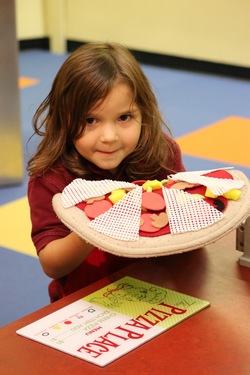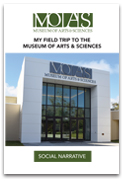Reservations

We are now booking for January-May 2025. Wednesdays are available for homeschool groups only. Please note that dates for public schools are limited due to the Lohman Field Study Program, which allows all 5th & 8th grade VCS students to visit the museum for free.
Review the educational guides and submit a Field Trip Request Form by filling out a digital form or by printing a form and sending it to either groupinfo@moas.org or nicolem@moas.org. Your request will be answered as soon as possible. Please fill out the entire form. If the dates that you have submitted are already booked, we will try our best to make accommodations for your group. A minimum of 15 students are required to book a field trip (summer trips may vary).
Field Trip Form (Digital) >
Field Trip Form (Print) >
Payment
Payment* for the Field Trip should be made the day of the trip. Payment can be made by check, money order, cash, or credit card.
Cancellation
If you need to cancel your Field Trip, please contact the Group Tour office at 386-255-0285 ext. 312 at least 48 hours prior to your scheduled visit.
Chaperone Requirements and Responsibilities
Teachers are free. All chaperones will pay the program rate ($8.00). Chaperones are responsible for the behavior of the group and are required to supervise and stay with students at all times during the field trip. The chaperone count should not exceed 1 chaperone per 10 student ratio.
Program Rates
You may choose three activities for $9.00 per person. Only one stage show is permitted.
A minimum of 15 students are required to book a field trip (summer trips may vary).
*MOAS Membership benefits for children and adults, such as free admission, are not valid for field trip payment.
Gallery tours include the Root Family Museum, the Prehistory of Florida Gallery, the American Art Gallery, and the Cuban Museum. The Cici and Hyatt Brown Museum of Art is included, but only by special requests.
Hands-on classes include Hands-on Energy, Milky Way, Fossils, or Oceans of the Deep. Hands-on classes are reserved for small groups (30 students or less).
| Program |
Specific Program (if applicable) |
Length of Program |
| Educational Programs |
Energy, Fossils, Ocean |
30 - 40 minutes |
| Planetarium Show |
|
45 minutes |
| Children's Museum |
|
30 minutes |
| Gallery Tours |
Root Family Museum, Prehistory of Florida Gallery, American Art Gallery, Cuban Museum |
30 minutes |
Group Guidelines and Rules
- No large backpacks unless carrying medicine for students.
- No food or drink allowed. Drinking fountains are available throughout the Museum.
- No smoking or vaping.
- No touching of the artwork or glass cases. Keep a safe distance from all artwork. No climbing on the sculptures in the Sculpture Garden.
- No running, rough play, pushing or yelling.
- Please move through the Museum halls quietly in straight lines.
- Chaperones must stay with the group.
- Photography is allowed without the use of a flash.
- Please help clean up the Children's Museum before your departure.
- Have fun while learning!
Directions and Bus Parking
Please have bus drivers pull into the south parking lot (next to the Sculpture Garden and the Children's Museum). The bus driver will park in the south parking lot. Lunches stay on the bus if the group is eating on the MOAS campus.
Field Trip Details
Galleries and Children's Museum
- Charles and Linda Williams Children's Museum: Walk through the Children's Museum and discover the latest and greatest hands-on exhibits the MOAS has to offer. This is the first museum in Volusia County to feature exhibits focusing on physics and engineering. Students will love this interactive and fun approach to science!
- Root Family Museum: The Root Family Museum features one of the largest Coca-Cola memorabilia collections in the world, 800 teddy bears, Indy Series cars, two historic railroad cars, and other popular Americana.
- Cuban Museum: The Cuban Foundation Museum is home to one of the most important collections of Cuban fine and folk art outside of Cuba. The collection chronicles 300 years of Cuban history and art in more than 200 objects. Highlights include extremely rare 18th, 19th, and early 20th century maps, documents, lithographs, painting, furniture, sculpture, and ceramics.
- Early American Art: The Dow Gallery of American Art is designed to showcase selections from the Museum's largest growing American collection of furniture, painting, watercolors, drawings, and the decorative arts including silver and glass. The gallery is interpreted chronologically with emphasis on the Pilgrim Century, the 18th century and the American Victorian Period.
- Prehistory of Florida Gallery: The impressive 13-foot tall skeleton of the Eremotherium laurilladi or Giant Ground Sloth was excavated in 1975, in an important Pleistocene fossil site call the Daytona Bone Bed. Dr. Gordon Edmund, Curator of Vertebrate Paleontology at Canada's Royal Ontario Museum, identified and reconstructed the sloth for MOAS.
Stage Shows
- Energy: The student audience will participate in a variety of tasks related to Energy. During the show, students will learn about the physics of energy and how it is all around us by using sounds, light, heat, and electricity as examples.
- Fossils: Discover our amazing collection of fossils dating back to the Mesozoic Era and learn about one of the Earth's most successful species.
- The World's Oceans: Students will explore the great oceans of the world through this interactive stage show. Students will travel through time to observe the creation of our oceans, explore ancient and exotic deep-sea creatures and marine environments, and review the recent state of our oceans.
Hands-On Classes (reserved for smaller school groups)
- Hands-On the Milky Way: Students will explore the wonders of our own galaxy through various hands-on activities as they learn about orbits, stars, planets, moons, and many other fascinating phenomena. The students will also be able to understand the size of our planetary neighborhood by building a scale model of the Solar System.
- Hands-On Energy: Students will participate in a variety of tasks related to Energy. During the class, students will learn how energy is all around us by using sounds, light, heat, and electricity as examples.
- Hands-On Oceans of the Deep: Students will learn about ancient and modern oceans and how they have changed over time due to the plate tectonics. From the ancient shark Megalodon to the gentle and giant blue whale, all the plants and animals of our oceans will have a place in this show. the tiniest plants and animals are also included (phytoplankton and zooplankton) and their important role in the food chain is not forgotten. The lasting impression is the human impact on oceans and what we can do to protect our greatest natural resource.
- Hands-On Fossils: Students will tour the Prehistory of Florida Gallery and discover the ancient animals of our state including Giant Ground Sloth and other ice age mammals. Students will then participate in studying and identifying Florida fossils as well as studying bones and artifacts.
 Social Narrative
Social Narrative
Families, teachers, and other service providers that support youth and adults on the Autism spectrum can prepare for a visit to the Museum of Arts & Sciences (MOAS) with this social narrative. This document is a step-by-step guide of what to expect when visiting including photographs and descriptions, ideals for visitors on the Autism spectrum and those who benefit from having clear expectations.